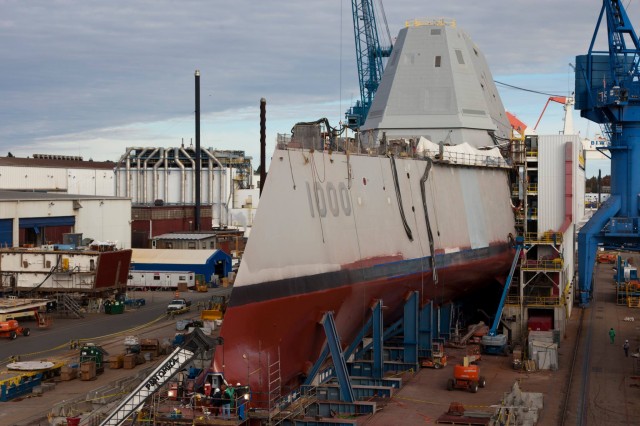
The USS Zumwalt getting a coat of paint at
Bath Iron Works. The ship is exotic in many ways, but it runs on
off-the-shelf computing technology.
General Dynamics Bath Iron Works
On October 10, I flew up to Rhode Island to visit Raytheon's Seapower Capability Center in Portsmouth, where engineers assembled and pre-tested the systems at the heart of the Zumwalt and are preparing to do the same for the next ship in line, the USS Michael Monsoor—already well into construction. There, Raytheon's DDG-1000 team gave me a tour of the centerpiece of the ship's systems—a mockup of the Zumwalt's operations center, where the ship's commanding officer and crew will control the ship's sensors, missile launchers, guns, and other systems.
Over 20 years ago, I learned how to be a ship watch stander a few miles from the Raytheon facility at the Navy's Surface Warfare Officer School. But the operations center of the Zumwalt will have more in common with the fictional starship USS Enterprise's bridge than it does with the combat information centers of the ships I went to sea on. Every console on the Zumwalt will be equipped with touch screens and software capable of taking on the needs of any operator on duty, and big screens on the forward bulkhead will display tactical plots of sea, air, and land.
Perhaps it's appropriate that the first commanding officer of the Zumwalt will be Captain James Kirk (yes, that's actually his name). But considering how heavily the ship leans on its computer networks, maybe they should look for a chief engineer named Vint Cerf.
Off the shelf and on the ship
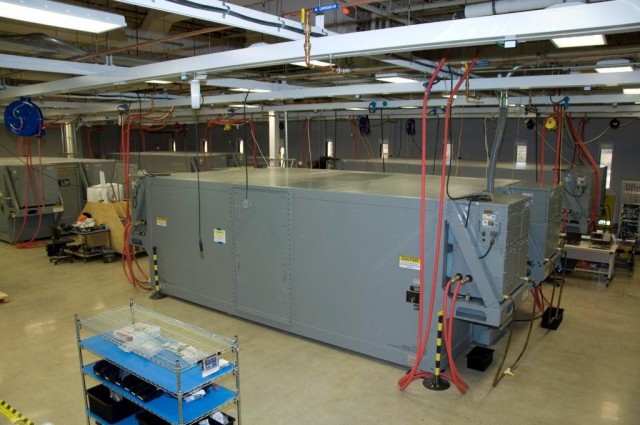
Enlarge / Data center in a box: Electronic Modular Enclosures being configured at Raytheon's Portsmouth, Rhode Island, facility.
The design of the Zumwalt solves that problem by using off-the-shelf hardware—mostly IBM blade servers running Red Hat Linux—and putting it in a ruggedized server room. Those ruggedized server rooms are called Electronic Modular Enclosures (EMEs), sixteen self-contained, mini data centers built by Raytheon.
Measuring 35 feet long, 8 feet high, and 12 feet wide, the 16 EMEs have more than 235 equipment cabinets (racks) in total. The EMEs were all configured and pre-tested before being shipped to Bath, Maine, to be installed aboard the Zumwalt. The EME approach lowered overall cost of the hardware itself, and allows Raytheon to pre-integrate systems before they're installed. "It costs a lot to do the work in the shipyard," said Raytheon's DDG-1000 deputy program manager Tom Moore, "and we get limited time of access."
Each EME has its own shock and vibration damping, power protection, water cooling systems, and electromagnetic shielding to prevent interference from the ship's radar and other big radio frequency emitters.
The EMEs tap into the Total Ship Computing Environment, the Zumwalt's shipboard Internet. Running multiple partitioned networks over a mix of fiber and copper, TSCE's redundantly switched network system connects all of the ship's systems—internal and external communications, weapons, engineering, sensors, etc.—over Internet protocols, including TCP and UDP. Almost all of the ship's internal communications are based on Voice Over IP (with the exception of a few old-school, sound-powered phones for emergency use).
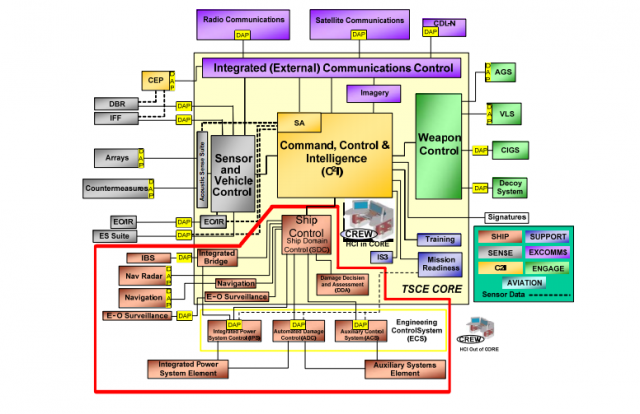
Enlarge / A diagram of the Zumwalt's control systems and their connections to the Total Ship Computing Environment.
Systems that weren't built to be wired into an IP network—other "programs of record" within the ship, which are installed across multiple classes of Navy ships—are wired in using adaptors based on single-board computers and the Lynx OS real-time Linux operating system. Called Distributed Adaptation Processors, or DAPs, these systems connect things like the ship's engineering systems, fire suppression systems, missile launchers, and radio and satellite communications gear into the network so they can be controlled by networked clients.
It looks like you want to launch a missile
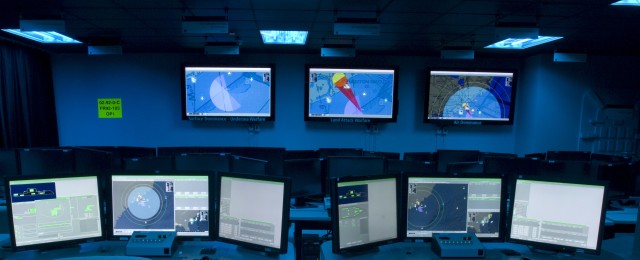
Enlarge /
The mock-up of the Zumwalt's operations center at Raytheon's Portsmouth
facility, complete with haze-gray paint, has the exact dimensions of
the space on the ship itself. The Zumwalt will include a second level to
host the operations of units deployed with the ship.
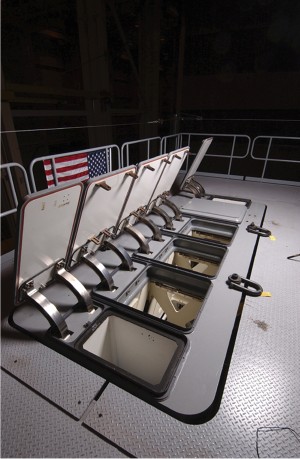
Enlarge /
The Mark 57 vertical launch system, developed by Raytheon, can carry a
mix of anti-ship, anti-aircraft, and land attack cruise missiles. It
communicates with the operations center over the ship's network.
This may not seem like a big deal to most people. But on past ships, workstations tended to be purpose-built for a specific weapons system or sensor. That meant every system had a different configuration and interface, and you couldn't have a watch stander handle multiple tasks without having to switch seats. The CDS workstation uses common USB interfaces for its peripheral devices (such as trackballs and specialized button panels) and is equipped with touchscreens, as well, so that watch standers have a choice between "classic" and touch interfaces.
That doesn't mean there's necessarily a "Clippy" to help new operators master their systems. The Raytheon team has had sailors in to perform usability assessments from before code was even written, showing them screen shots of interfaces to get feedback from users. "We had a chief that said, 'We don't want any 'wizards,'" said Froncillo.
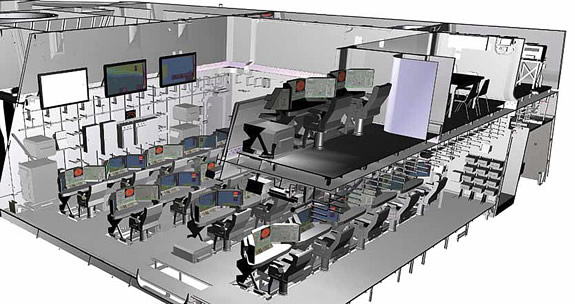
A
digital illustration of how the Zumwalt's operations center will look,
complete with its second-level suite for hosting operations for air
detachments and other units deployed aboard.
Raytheon
The next release
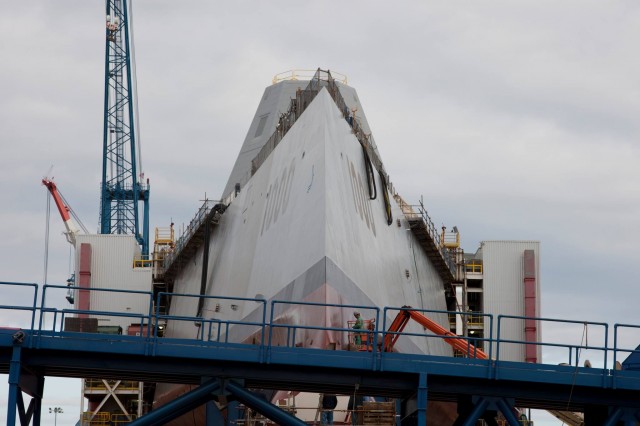
Enlarge / The Zumwalt bow-on at Bath Iron Works. DDG-1001, the USS Michael Monsoor, sits behind her, more than 60 percent complete.
But the life of the technology being deployed on the Zumwalt won't end there. CDS will be used as part of the Navy's Aegis Modernization Program to upgrade the systems of the fleet's guided missile cruisers and destroyers. "And there are a lot of things we're developing that will be reused," Moore said.
Considering how much has been spent over the past decade trying to get the Zumwalt built, and the other technologies that were developed in the process, one can hope that more than just the software gets some reuse.
No hay comentarios:
Publicar un comentario